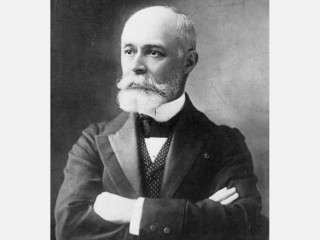
Antoine Henri Becquerel biography
Date of birth : 1852-12-15
Date of death : 1908-08-25
Birthplace : Paris, France
Nationality : French
Category : Science and Technology
Last modified : 2010-12-08
Credited as : Physicist, discoverer of natural radioactivity, won the Nobel Prize in physics in 1903
The French physicist Antoine Henri Becquerel was the discoverer of natural radioactivity.
Antoine Henri Becquerel was born in Paris on Dec. 15, 1852. Both his father, Alexandre Edmond Becquerel, and his grandfather, Antoine Cesar Becquerel, were scientists. Following his graduation from the Ecole Polytechnique in 1874, Antoine Henri worked as a civil engineer, but he also retained a strong interest in scientific problems. In 1878 he succeeded in the chair of his father who was professor of applied physics at the Conservatoire des Arts et Metiers. Ten years later Becquerel earned his doctor's degree with a dissertation on the absorption of light in crystals. He then became professor of applied physics at the Museum of Natural History in Paris in 1892 and professor of physics at the Polytechnique in 1895.
Prior to 1895 Becquerel did research on phosphorescence. He had inherited from his father a supply of uranium salts, which were known to be phosphorescent when exposed to light. Upon learning in January 1896 about W. C. Roentgen's discovery of x-rays, Becquerel's interest immediately turned to the question of whether all phosphorescent materials acted as sources of similar rays.
The results did not justify his hopes, but Becquerel stumbled on an unexpected phenomenon. After placing sheets of sulfate of uranium on photographic plates wrapped in black paper, he exposed the package to light for several hours. On developing the plates he obtained distinct pictures of the uranium sheets. Later he obtained pictures of medals which had been placed between the uranium and the plates. The uneven thickness of the medals blocked in varying degrees the effectiveness of the radiation from uranium. He also discovered that part of the radiation could be deflected by a magnetic field and that the radiations had an ionizing effect on the surrounding air.
For the discovery of natural radioactivity, which for a number of years was called Becquerel rays, he won the Nobel Prize in physics in 1903. In his Nobel lecture Becquerel noted that the new radiation indicated the possible modification of atoms which "the methods at our disposal are unable to bring about (but which) could certainly release energy in sufficiently large quantities to produce the observed effects, without the changes in matter being large enough to be detectable by our methods of investigation." As a cause of that modification, he held out the possible existence of "an external radiation" hitherto undetected but which, when absorbed by radioactive materials, would be transformed into radioactivity without bringing about the transformation of the atoms themselves.
Becquerel's election as perpetual secretary of the Academy of Sciences in 1908 was one of the numerous honors bestowed on him. His death on Aug. 25, 1908, at Le Croisic did not signal the end of the lineage of scientists in the Becquerel family. From Becquerel's marriage to Lucie Zoe Marie Jamin a son, Jean, had been born; he became the fourth Becquerel to occupy the chair of physics at the Museum of Natural History and was also an able investigator of radioactivity.
The major work on Becquerel is in French. A detailed account of Becquerel's life is in Bessie Zaban Jones, ed., The Golden Age of Science: Thirty Portraits of the Giants of 19th-century Science by their Scientific Contemporaries (1966). Nobel Lectures: Physics, 1901-1921 (1964), published by the Nobel Foundation, includes a biographical sketch of Becquerel as well as his Nobel lecture on radioactivity. A biographical sketch is also contained in Niels Hugh de Vaudrey Heathcote, Nobel Prize Winners in Physics, 1901-1950 (1953). For background material see Harvey E. White, Classical and Modern Physics (1940).
















